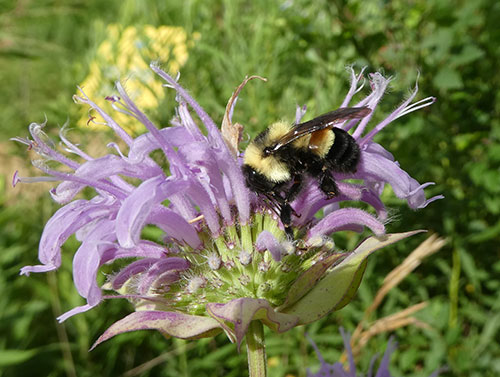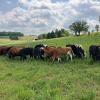Known to Dakota people as Oheyawahi, “the hill much visited,” Pilot Knob Hill in Mendota Heights, MN, lived up to its name when citizen scientists and eager volunteers gathered recently on the hill to hunt for some rare Minnesota species. Sarah Foltz Jordan of the Xerces Society, Elaine Evans of the University of MN Bee Lab, and Great River Greening ecologists led a “catch and release” bumble bee survey for volunteers who learned to identify a number of species endemic to the area. Designed to monitor the abundance, diversity, and foraging patterns of bumble bees—including searches for the rusty patched bumble bee and other rare Minnesota species—this ongoing monitoring project is helping the Xerces Society and Great River Greening evaluate the tie-in between restoration practices and pollinator management. Training citizens in pollinator conservation is another key objective of this project Volunteers received a bumble bee conservation training kit, including pocket ID guides, conservation guidelines, native plant recommendations, and more. The project is made possible with support from the Minnesota Environment and Natural Resources Trust Fund.
More than one hundred bumble bees comprising 6 different species were recorded during the survey. Two species were found that had not previously been documented at the site: the American bumble bee (Bombus pensylvanicus) and the rusty patched bumble bee (Bombus affinis), both imperiled species that have been in decline in this region and elsewhere. While these two species were found in very low numbers compared to the other bees present—just one rusty patched and five American bumble bees—finding any at all is exciting given their very low numbers, and recent, rapid declines. The presence of these species at the Pilot Knob Hill restoration site is of great significance to both the conservation community as they assess the distribution and needs of these species, and to the site’s managers as they make decisions on the ground to best protect and benefit the wildlife at the site.

The two-spotted bumble bee (B. bimaculatus) and the black and gold bumble bee (B. auricomus) were the most abundant bees in this survey; both of these bees are known to be common and not of conservation concern at this time.
The vast majority of bees were found visiting wild bergamot (Monarda fistulosa), a native flower in the mint family that is well known for its attractiveness to pollinators, especially bumble bees. A couple of bumble bees were found on hoary vervain (Verbena stricta), a native plant in the verbena family, and one bee was found on Canada thistle (Cirsium arvense), a nonnative thistle from Eurasia.
One bumble bee species, the yellow bumble bee (B. fervidus), which was detected in low numbers last year at the site, was not found during this year’s survey. This is another rare bee of conservation concern, and we hope to find it again during our surveys at Pilot Knob in the coming months.



